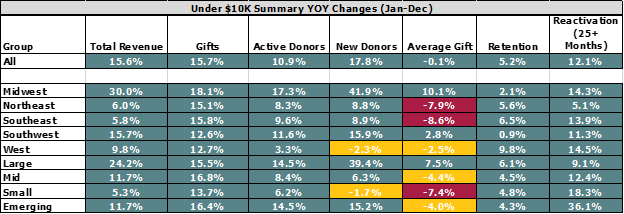It’s no secret that nonprofit organizations saw record levels of response from donors throughout the majority of 2020—a direct result of the pandemic.
But how exactly did the numbers play out when the dust settled? Did donors who gave during the spring give again at year end? What did the rise in revenue do to impact things like average gift, gift frequency, donor counts and more?
Well, we’ve tabulated the numbers for some of our clients, and we have some answers.
In this blog, we’re sharing data from our annual Food Bank and Animal Welfare Client Benchmark Reports to show an overall look at the fundraising landscape throughout 2020.
Before we reveal the findings, let’s first take a look at industrywide results from the recently released 2020 Q4 Fundraising Effectiveness Project (FEP) Report.
 Driven by an increase in new and reactivated donors, overall charitable giving increased from 2019 to 2020 by 10.6%. Active donors were up 7.3%, but retention fell -4.1%.
Driven by an increase in new and reactivated donors, overall charitable giving increased from 2019 to 2020 by 10.6%. Active donors were up 7.3%, but retention fell -4.1%.
How did RKD’s clients measure up? Keep reading to find out.
Food banks saw exponential growth
Last September, we reported on the surge in donations food banks were seeing through the first half of 2020.
A big question on everyone’s minds was whether donors would step up to help their neighbors again in December or whether they felt “tapped out” from giving earlier in the year. RKD co-commissioned donor sentiment research with The Nonprofit Alliance and found that donors said they still had more to give at year end.
With so many new donors during the spring and summer, some food banks wondered whether they should pull back on acquisition efforts to close out the year. Based on our research, we advised our clients to stay the course and keep investing in their growth.
Still, we wondered whether donors’ actions would match their words. Now that we have data from the full year, we see the answer is clearly yes.
The unprecedented growth in charitable giving to food banks, which started in March, continued through December.
While April had the highest growth in revenue and new donors as a percentage year over year, December had the largest growth in new donors and revenue based on raw numbers.
Revenue grew by $54 million in the month of December alone, and 161,154 new donors were acquired for the 76 food banks across the U.S. whose full files we analyzed. That’s more new donors in one month than in all of 2019 combined!
These numbers are simply stunning.
Overall revenue increased 179% year over year. Active donors more than doubled—up 113%. New donors jumped 348%.
Every single metric in every single region was up. We’ve never seen a chart completely covered in green like this:

In order to grasp the magnitude of these stats, here’s a quick revenue comparison across the last five years (gold represents highest previous contributions of $10,000 or more):
It was truly a year like no other for food banks.
Animal welfare organizations were a different story
Nonprofits that had no direct connection to the COVID response efforts saw a much different 2020 than food banks did. Thankfully, for the 79 animal welfare clients who shared their files with RKD, the numbers were still good.
Overall, revenue was up 15.6% over 2019. Active donors (+10.9%) also increased, and retention was up 5.2%.
These aren’t the same jaw-dropping numbers that food banks saw, but they are better than industrywide numbers for 2020.
Going back to the beginning of this blog, the FEP reported that nonprofits saw a 10.6% increase in revenue, a 7.3% increase in active donors and a -4.1% drop in retention. And Blackbaud’s Charitable Giving Report showed animal welfare organizations having a worse 2020 than 2019—with a -0.7% drop in revenue.
Our animal welfare clients bested each of those categories.

For animal welfare organizations, the COVID effect was felt primarily with existing donors. We can see that in the charts below where YOY revenue increased from March through November, while new donor growth stayed flat.
Our strategists chose to hold back a bit on acquisition efforts early on in the pandemic and focus on retention and lapsed reactivation. Then, we pushed harder into acquisition at the end of the year, and the results show the growth in new donors in December.
All in all, we’ve seen the COVID effect across a lot of areas in the nonprofit industry—and it looks a little different in each one.
Clearly, the closer an organization was to the pandemic response, the more they were on the news and top of mind for donors. But even those charities that had little to no ties to the pandemic were able to tap into donors’ emotions.
People wanted to help in any way they could to make the world a better place. And that’s really the best stat we can highlight.





Leave a comment: